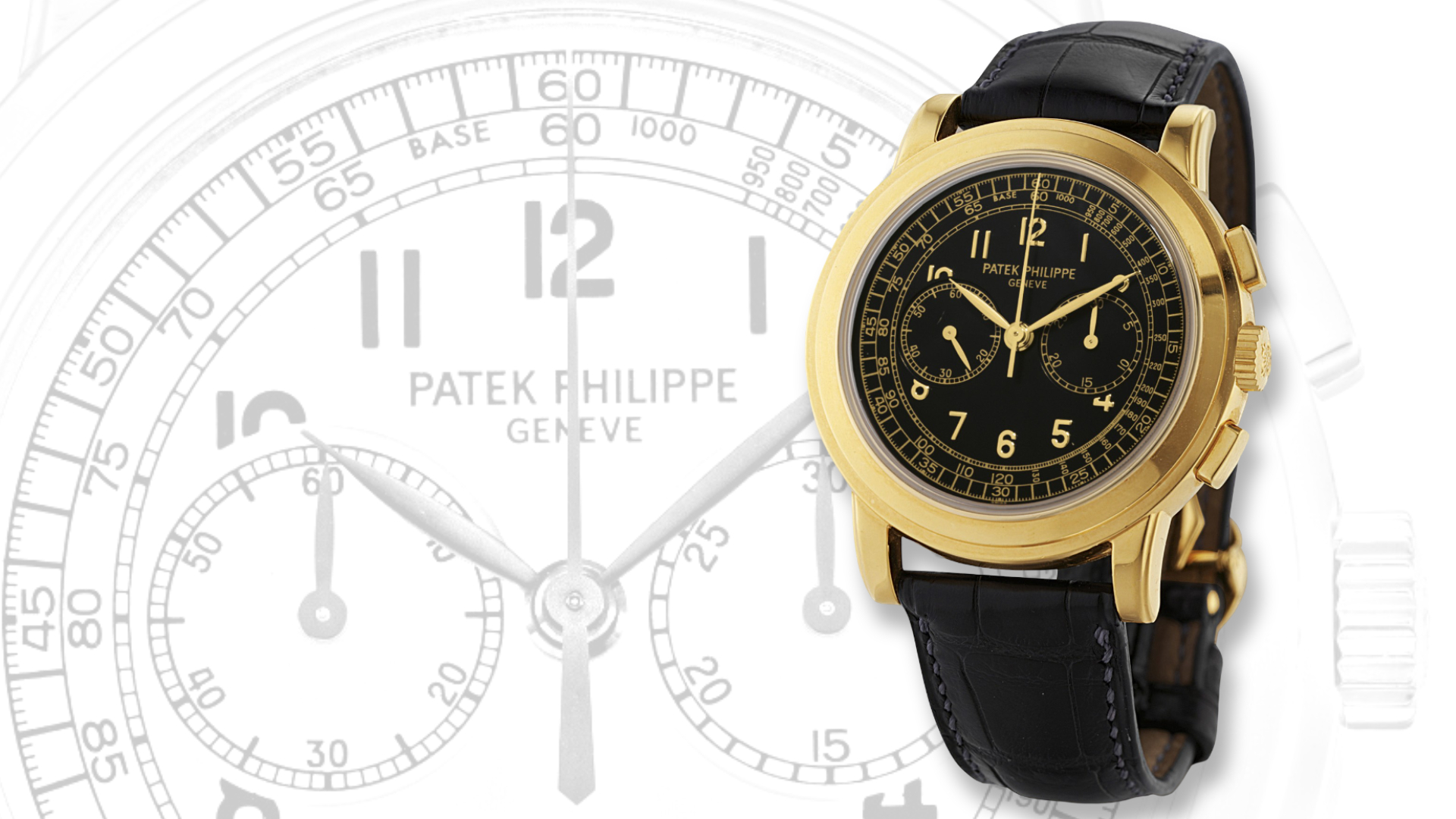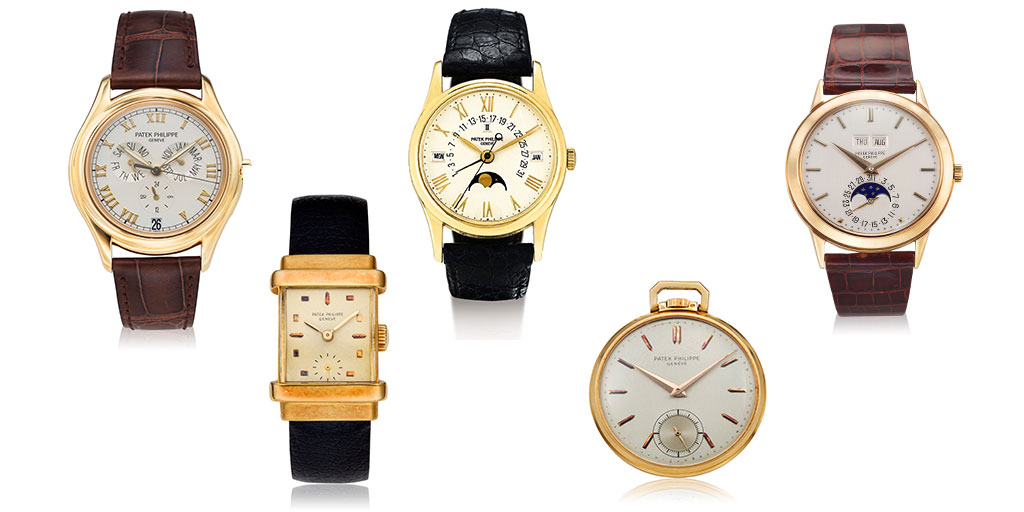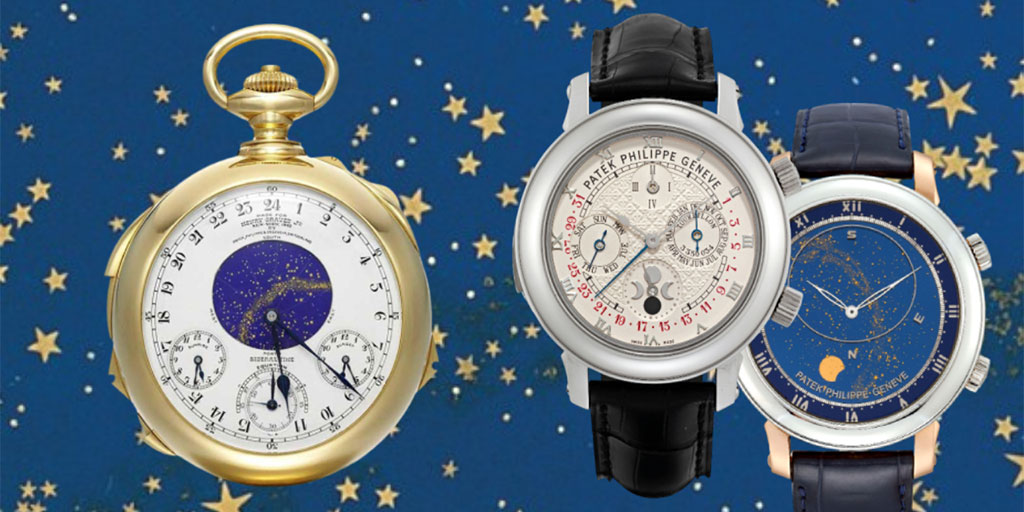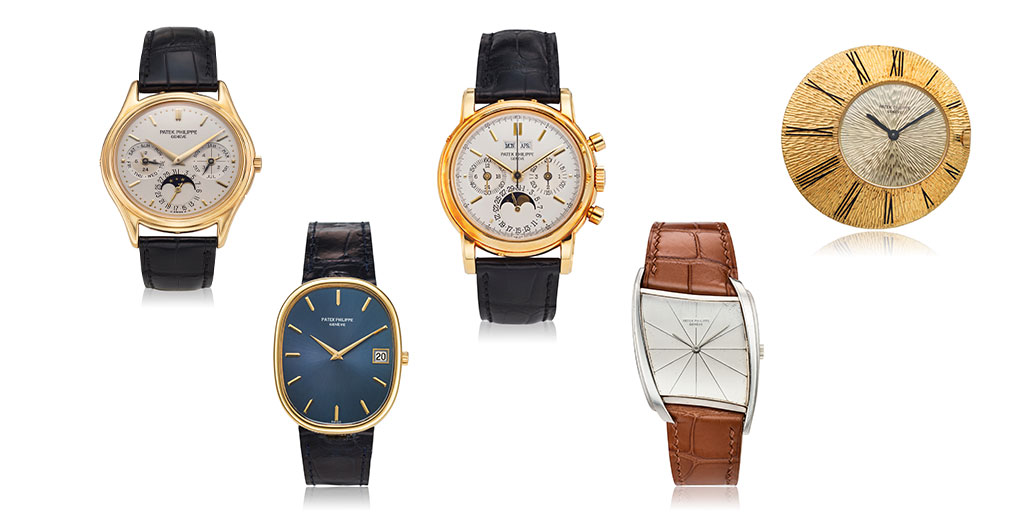Introduction
When Patek Philippe unveiled the ref. 5070 at Baselworld 1998, it marked a notable return to form: the manufacture’s first serially produced, simple chronograph in over three decades. The last such piece, the celebrated “Tasti Tondi” ref. 1463, had concluded production around 1965. In the intervening years, Patek Philippe had continued its perpetual calendar chronograph tradition uninterrupted—but the unadorned chronograph had been absent from the catalog.
The ref. 5070 was anything but a timid comeback. At 42mm, it was audaciously large for its era, dwarfing the 33-35mm Calatravas and the 36mm perpetual calendar chronographs that dominated the collection. Yet this boldness was deeply rooted in Patek Philippe’s own history, drawing direct inspiration from the extraordinary ref. 2512—a 46mm split-seconds chronograph from 1952.
Beyond its striking presence, the ref. 5070 represented a pivotal moment in horological evolution: it would be the last Patek Philippe chronograph to employ an ébauche movement, the celebrated and highly modified Lemania-based caliber CH 27-70.
The design philosophy behind the watch proved remarkably prescient. Its large case preceded the industry’s shift toward bigger proportions in the 2000s. The dial layout—with its expansive twin counters, bold applied numerals, and intelligent use of scales—achieved exceptional legibility without visual clutter.
Despite these achievements, the ref. 5070 has remained somewhat overlooked in collectors’ consciousness. This article aims to examine its historical heritage, its case and dial design, its movement, the market evolution, as well as its bold diamond-set sibling ref. 5071 to explore a watch that deserves greater recognition as one of the most remarkable chronographs of the modern era.
Patek Philippe’s Chronograph Heritage
Patek Philippe has a very long tradition of producing chronograph watches, one of the earliest dates back to 1856 with pocket watch no. 10,051, with a large chronograph hand and jumping seconds (seconde foudroyante) in a subsidiary dial. As it did not have a zero-reset mechanism, a separate key was needed to reset it for each measurement.
One of the earliest known wristwatch with a chronograph, actually a split-seconds function, is No. 124,824 and was delivered at a client’s request in 1923. Interestingly, production started as early as 1903 and the watch was only delivered two decades later. The watch first resurfaced publicly at the 1989 The Art of Patek Philippe auction before Sotheby’s offered it again in 2014 where it sold for $2,965,000. It now resides in the Patek Philippe Museum.
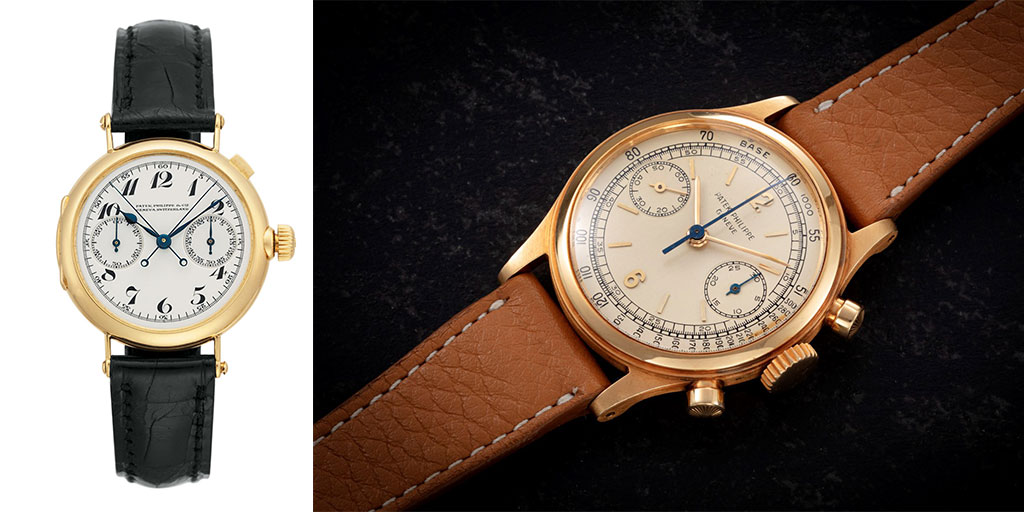
The last chronograph in Patek Philippe’s early production is the celebrated “Tasti Tondi” ref. 1463. First introduced in 1940, it remained in the offer until around 1965 with about 350 examples made in various metals and dial configurations. Using the famous caliber 13-130 (based on Valjoux 23), it featured round pushers and was Patek Philippe’s first water resistant chronograph. And while perpetual calendar chronographs remained in production (refs. 2499, 3970, 5004), no simple chronograph was serially produced for three decades to come.
A Unique Piece as Inspiration
This changed dramatically in 1998 with the introduction of ref. 5070. This new timepiece took inspiration from an even larger watch, the unique piece, ref. 2512J, produced in 1950 and sold on July 14, 1952, which the inaugural press release explicitly references. The watch housed a split-seconds chronograph movement – the split-seconds function being controlled by a pusher coaxial with the crown. The 46mm case size was very unusual in the 1950s, which is considered a period of more subdued taste, and probably takes inspiration from 1930s and 1940s pilot watches (see Longines Lindbergh for instance), who used them as navigation tools and needed perfect legibility. The yellow gold case featured a stepped bezel and stepped lugs, while the black dial with applied numerals and gilt text adds a dramatic contrast. It was first sold at Antiquorum in 1996 and then at Christie’s in 2000 for CHF 1,439,750. It is now part of the Patek Philippe Museum collection. While the watch had long been known to Patek Philippe (it is illustrated in the 1988 Patek Philippe Wristwatches by Martin Huber & Alan Banbery, 1st edition) it only joined the Museum collection two years after the launch of ref. 5070.
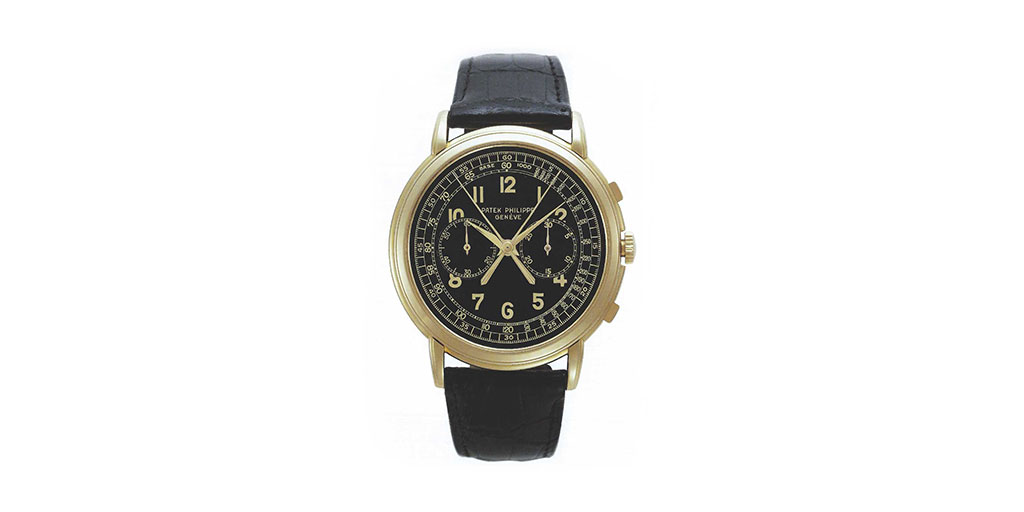
Another unique piece of the same era must be mentioned: the ref. 2512/1J. While a time-only watch, it shares a lot of the same design codes: 46mm stepped case, yellow gold, black dial with gilt text and even the same reference beginning. This watch was made for the French market as can be the seen with the “fab. suisse” mention on the dial and the “JG” stamp inside the case, which stands for Jean Guillermin – Patek Philippe’s French importer at the time – and the French official gold hallmarks. The watch was first sold at Sotheby’s in 1988, then again in 2012 for $962,500 and is now part of Patek Philippe Museum.

The Case
The first striking element of the ref. 5070 case is the 42mm size. While significantly smaller than the ref. 2512 at 46mm, it stood out dramatically among the rest of the collection at Baselworld in 1998. To put it in context, at that time most Calatrava watches measured 33-35mm, the Nautilus ref. 3800 measured 37mm (the 42mm ref. 3700 had been discontinued in 1990), the perpetual calendar chronographs ref. 3970 and ref. 5004 measured 36mm. The ref. 5070 reflected the avant-garde spirit of Patek Philippe and marked the beginning of a new trend in the watch industry towards larger cases in the 2000s.

From a design perspective, the case distinguishes itself by its multi-stepped construction: on the bezel, on the lugs, as well as on the case back, giving it a distinctive layered appearance, which somehow reduces the visual perception of its size. The overall height of 12 mm, as well as the downturned and beveled lugs, similar in style to the ref. 2499, enhance wrist comfort. The square pushers allow for easy use of the chronograph, while the crown with its Calatrava cross has been slightly recessed in the case band for smooth integration.
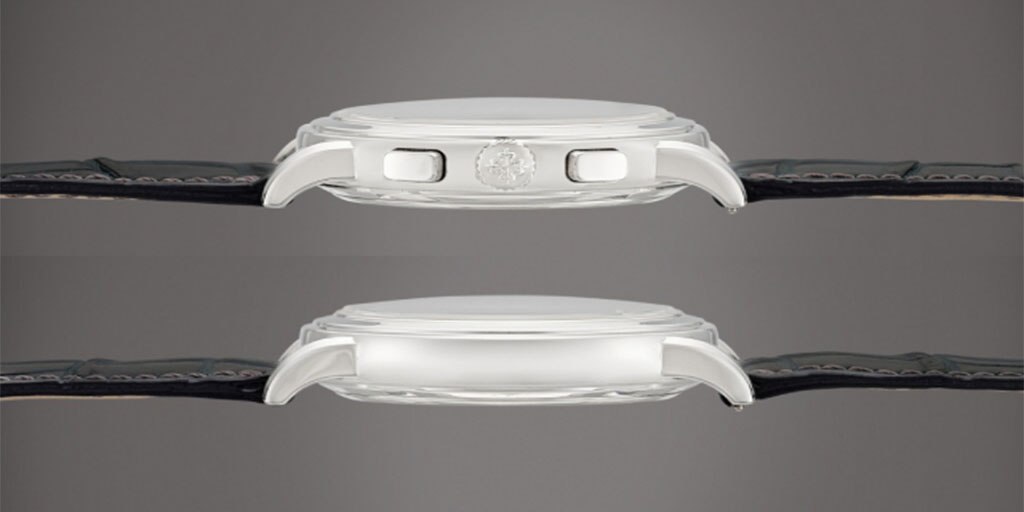
The precious metal hallmark placement has evolved over time. On early examples with yellow gold and white gold cases, the official Swiss hallmark (the head of a St. Bernard dog) was stamped on the outside of the 5 o’clock lug and the Common Control Mark (a scale) on the outside of the 11 o’clock lug, while the Fineness Mark (750) and the Makers Mark (PPCo) are under the 2 and 7 o’clock lugs. From around the year 2002 onward, all four hallmarks are stamped under the lugs.
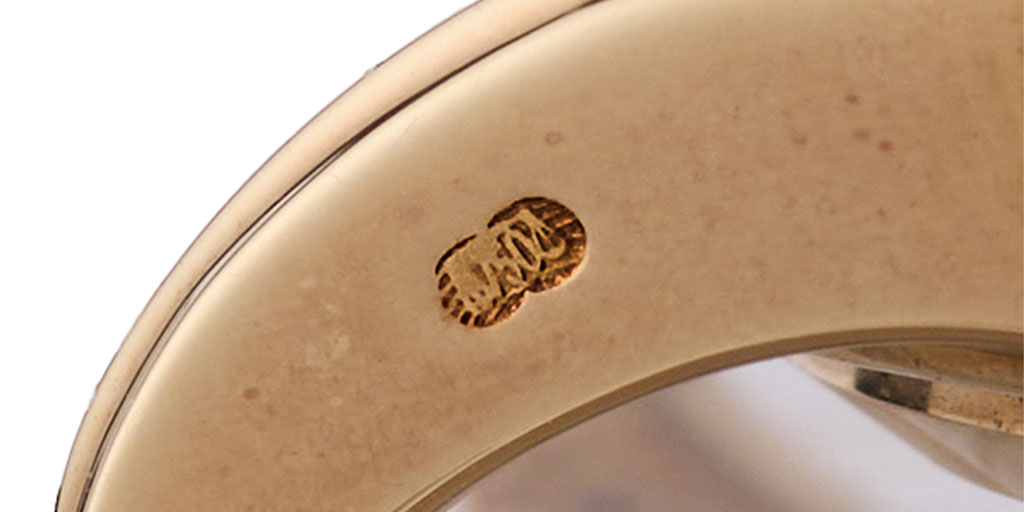
The ref. 5070 has been made in all precious metals: yellow, white and rose gold as well as platinum. Although a steel version has been rumored, no example is known to exist.

When examining the case condition of a ref. 5070, one should pay particular attention to the sharpness of the lugs and bezel. They are notoriously hard to polish, and if not done well, the edges tend to lose their initial shape. Hallmarks on the outside of the lugs on early versions also tend to fade after polishing. As always, excellent condition is worth the premium when buying any vintage or pre-owned watch and is in itself a rarity.
The Dial and Hands
The dial layout stays true to the original ref. 2512: two large counters at 3 (chronograph minutes) and 9 (small second) surrounded by large scales and applied Arabic numerals. This ensures excellent legibility.
In designing the dial, Patek Philippe had to overcome the “small movement in a large case” challenge. The movement base is the same as the ref. 3970, however the ref. 5070 is 6mm larger. The result is that the two counters are very much at the center of the dial with considerable negative space around them. Patek Philippe chose to add a tachymeter scale (which allows measurement of the average speed of an object traveling over one kilometer or one mile) and a seconds scale graduated in one-fifth-second intervals. The result is remarkably smooth, legible and clean.
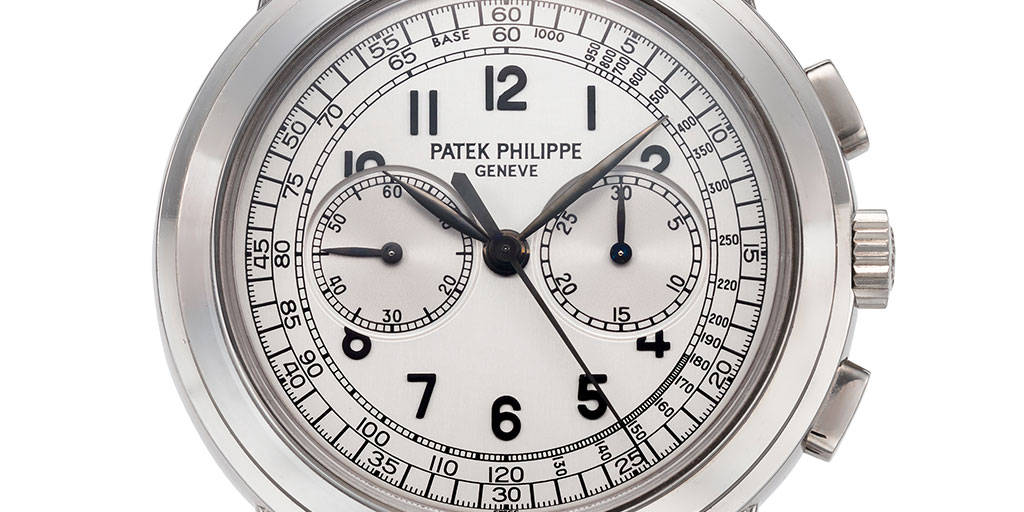
The hour, minute, and small counter hands all have a leaf (“feuille”) design, while the large chronograph hand has a baton style.
In regular production, each case was paired with a specific dial:
- Yellow gold, black dial (Certificate: “noir”), yellow gold hands and numerals
- White gold, opaline silver dial (“argenté”), blackened white gold hands and numerals
- Rose gold, metallic silver dial (“acier”), rose gold hands and numerals
- Platinum, blue dial (“bleu nuage”), white gold hands and numerals
Each version has its own charm: the yellow gold with its black dial creates a dramatic effect and has more vintage feel; the tone-on-tone white gold is the most subtle; the warmth of the rose gold contrasts with its metallic silver dial; the platinum features an unmistakable and immediately recognizable blue dial.

On the white gold version, the blackened hands and to a lesser extent numerals on the dial tend to take on a blue-gray-iridescent color. This aging is extremely frequent and occurs even in double-sealed examples that have never been opened (for a similar type of aging, see ref. 5970 in white gold).
The Movement
The ref. 5070 is the last Patek Philippe chronograph to use an ébauche movement and not an in-house movement. The CH 27-70 is based on the celebrated, manually-wound Nouvelle Lemania 2310 – which has been used by Patek Philippe since 1986 as a basis for the ref. 3970.
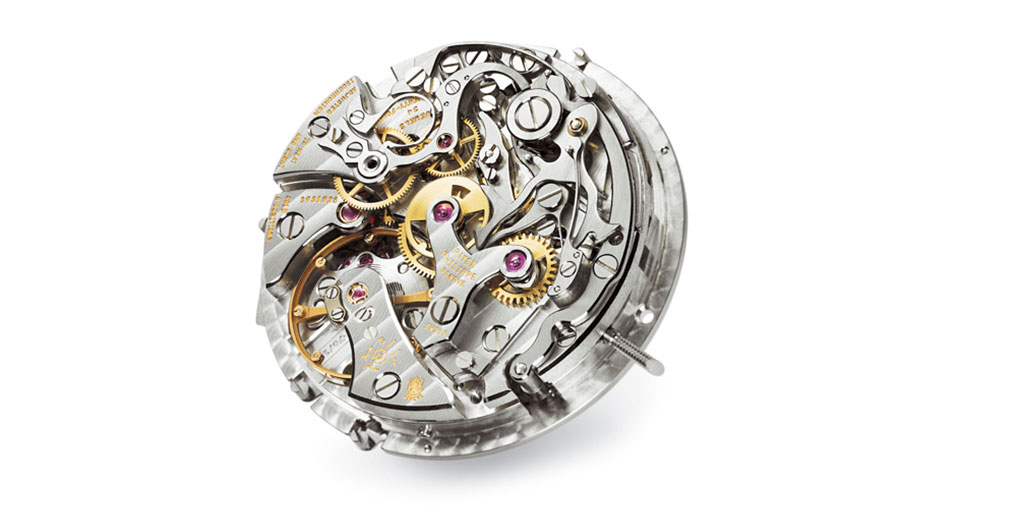
While not an in-house movement, the Lemania base has been heavily modified before being integrated into any Patek Philippe watch. In particular, several bridges and wheels have been redesigned, increasing the power reserve to 60 hours, a Gyromax balance wheel was integrated and every component has been decorated to the Geneva Seal standards. Notably, all movements bear the Geneva Seal, even those on watches that have been produced after the introduction of the Patek Philippe Seal in 2009. The result is one of the most elaborate and reliable chronograph movements of its era, cherished by collectors to this day.

Once again, the case design choices allow for the smooth integration of the movement, which is relatively small at 27.5mm in diameter, while the case measures 42mm. The caseback, similar to the bezel, has a stepped design and six notches have been added that are used for opening the case, thus framing the movement in the center and creating visual harmony. The beautifully decorated movement can be seen through the sapphire caseback.
The Full Set
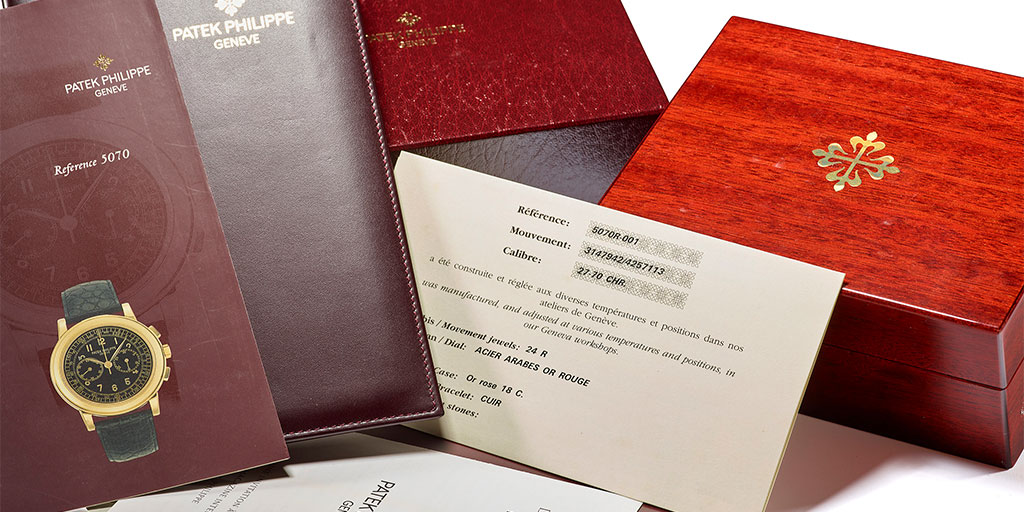
All watches came with an alligator strap and a deployant buckle of the same metal as the watch case.
The full set comprises:
- A wooden box and outer carton
- A leather portfolio with product literature and instructions for use
- A Certificate of Origin
Early models came with the reddish wood boxes, while from 2003-2004 onward, they came with the brown wooden boxes with an inlaid Calatrava cross.
A full set significantly adds to the collectability of the model and collectors are encouraged to seek complete examples.
Collectability
Production of the regular ref. 5070 ran for 11 years from 1998 to 2009, with the following periods by metal, a few pieces might have been produced even after these dates:
- December 1998-2001: yellow gold (ca. 3 years)
- End-2001-2007: white gold (ca. 6 years)
- Mid-2003-2007: rose gold (ca. 4 years)
- Mid-2008-2009: platinum (ca. 1 year)
The 1998 press release and Patek Philippe Magazine No. 10 (early 2000s) announced a yearly production of no more than 250 pieces, which would mean approximately 2,750 total pieces over 11 years. A few points are to be kept in mind: first, production output might have increased over the years, meaning the total production might be higher. This also means that one year of platinum production will likely be more than one year of yellow gold. Secondly, the production of the various gold models has overlapped and yearly output will have been split between the different versions. It is thus hardly possible to precisely estimate the production per metal and Patek Philippe will not officially confirm numbers.
Over the years, our database shows that 275 regular production models of ref. 5070 have appeared across the four major international auction houses Antiquorum, Christie’s, Phillips and Sotheby’s with the following breakdown (322 sales when counting watches sold multiple times):

Yellow and white gold appear to be the most frequent metals at auction. The rose gold and the platinum appear to be the rarest, with platinum the most thought after by collectors. Over the last 20 years, the price has remained largely stable and the three gold versions sell for similar prices. The platinum is considerably more expensive; though it also has the highest volatility.
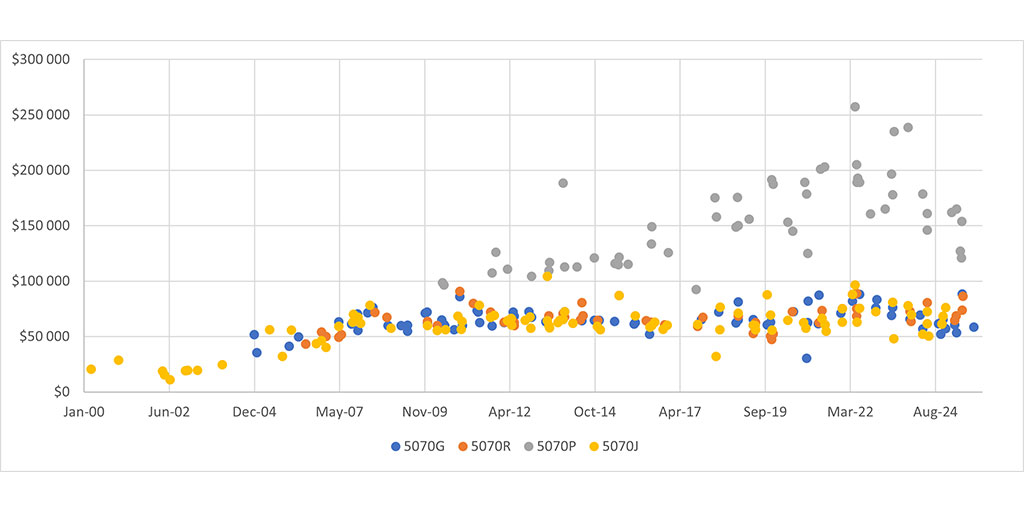
Limited Editions and Special Orders
A few special orders and special variants are known and always create a significant buzz when offered for sale. As Patek Philippe does not communicate about these pieces and often collectors prefer to keep their special commissions private, this list is by nature incomplete – if you wish to see your pieces featured, please contact us and we will be happy to include them.
The “Saatchi” Editions

Since the early days of the company, Patek Philippe has the tradition of attending exhibitions to show its creations to the public. Its first Grand Exhibition was held in October 2013 in Munich, Germany. The second such exhibition took place in 2015 at the Saatchi Gallery in London, UK and was also an occasion to celebrate Patek Philippe’s 175th anniversary. Among other new pieces, one of the rooms in the gallery displayed four ref. 5070 watches that had not been shown before and have since been nicknamed the “Saatchi” editions.
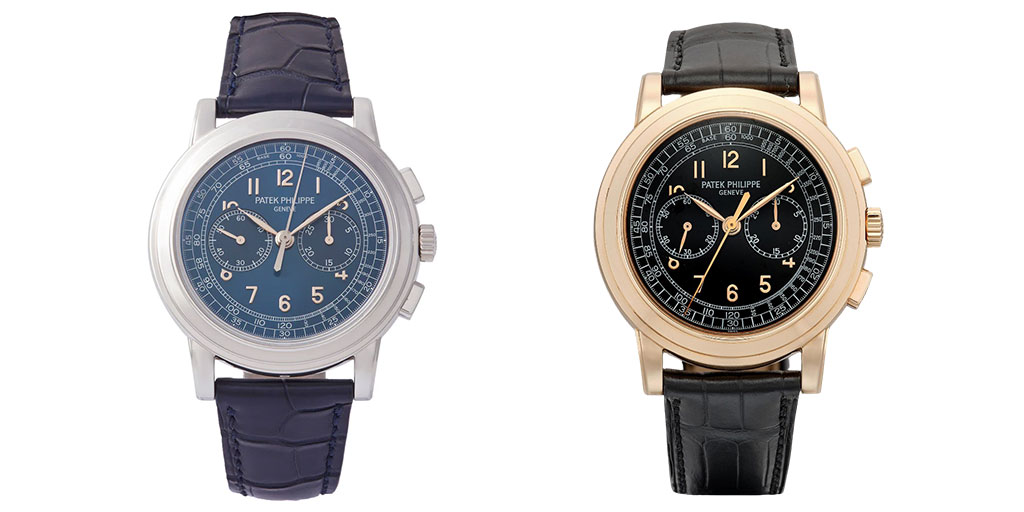
A few points are particularly noteworthy. First, by 2015, the ref. 5070 had been discontinued for six years and was no longer in production. The end-of-run editions used movements and cases that had remained unused in stock, all movements bear the Geneva Seal despite the introduction of the Patek Philippe Seal in 2009. Secondly, at least some of the watches have been sold as early as 2014 – that is almost a year prior to the opening of the Grand Exhibition – and other pieces have been sold as late as 2019-2020, years after the Exhibition.
Four watches have been made:
- 5070J-012: yellow gold with brown dial (Certificate: “brun”)
- 5070G-014: white gold with salmon dial (Certificate: “rose 5N”)
- 5070R-014: rose gold with black dial (Certificate: “noir”)
- 5070P-013: platinum with blue dial (Certificate: “H900.559.C2G”) – slightly brighter blue shade than the regular version
From a design perspective, the dials show a few subtle changes compared to the regular editions. Here are the most recognizable:
- Font: the most obvious tell is the zero numeral: it is rounder on the Saatchi editions, while it is more oval on the regular editions. The “1000” from the tachymeter scale is smaller on the Saatchi (about one-third of the space versus one-half on the regular editions)
- Appliques: the end parts of the appliques show an extra beveling
- Counters: digits in the sub-dials are further away from the ring track

The accessories for these watches are the same as haute horlogerie watches: a wooden box, a large leather portfolio with a picture, description, instructions for use and Certificate, and a small leather portfolio with product documentation.
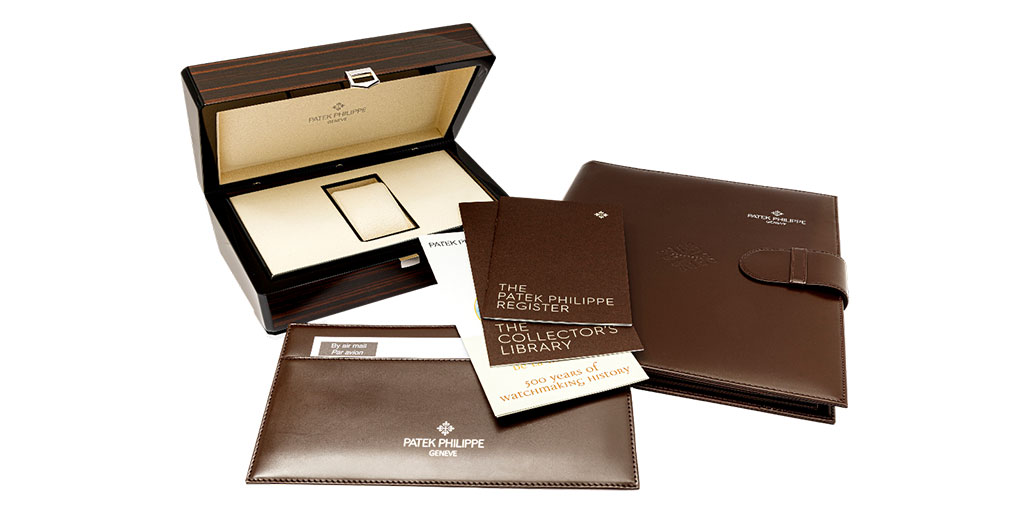
It is rumored that only five of each have been produced, and while it certainly is a little more, these remain very rare watches. Patek Philippe has never commented on any of these watches apart from showing them at the exhibition, nor shared production numbers.
These watches only appear sporadically on the secondary market and command significant premiums over the regular versions. These are the numbers of watches that have appeared across the four major international auction houses:
- Three yellow gold (last sale: Phillips, 2024, $478,698)
- Four rose gold (last sale: Sotheby’s, 2023, $324,331)
- Two white gold (last sale: Phillips, 2024, $591,681)
The platinum version has only appeared at a few secondary dealers.
The Michael S. Ovitz Set
Michael S. Ovitz is a former Hollywood talent agent who co-founded Creative Artists Agency (CAA) in 1975 and built it into one of the most powerful talent agencies in entertainment history. He later served briefly as president of The Walt Disney Company from 1995 to 1997 and is now primarily focused on venture capital investing and advising. He is also known to be a very important art collector and serves on the Board of Trustees of MoMa. An avid watch collector, he commissioned several dozen Patek Philippe special orders in the 2010s. These watches are remarkable as they discreetly feature Mr. Ovitz’s monogram “MSO” at 6 o’clock on the dial. Patek Philippe rarely allows such dial personalization, making visible monograms on the dial face an extraordinary privilege reserved for the most significant collector relationships.
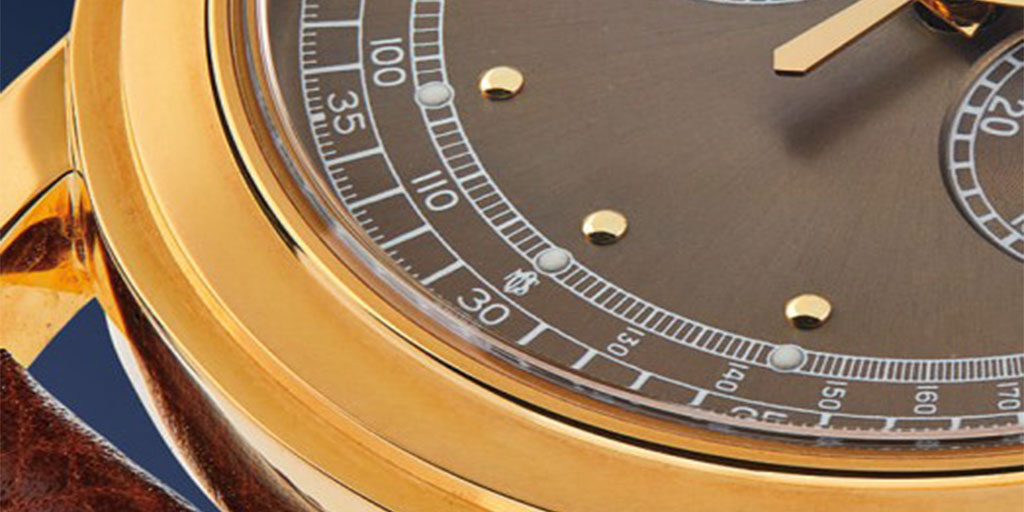
Two personalized ref. 5070 watches are known and the dials follow the exact same pattern with a Breguet 12, dots (instead of numerals), luminous dauphine hands and additional lume dots, and MSO monogram at 6:
- 5070J-010: yellow gold with brown dial, made in 2011 (Sold at Phillips in 2022 for $441,000)
- 5070X-0XX: white metal with salmon dial
Both are likely unique pieces.
Further Known Special Orders

Here are further special editions that have appeared publicly:
- 5070R-0XX: rose gold with black dial set with diamonds similar to ref. 5071, made in 2005 (Sold at Antiquorum in 2015 for $135,444)
- 5070G-0XX: white gold with slate dial set with diamonds similar to ref. 5071 (Source: @maurideangelis)
- 5070/1P-0XX: platinum with black dial and platinum bracelet (Sold at Sotheby’s in 2010 for $644,651)
- 5070P-001: white hands and hour markers. The piece initially left the factory in the regular configuration and was subsequently modified by Patek Philippe at the client’s request as registered by the archives (Sotheby’s, 2025)
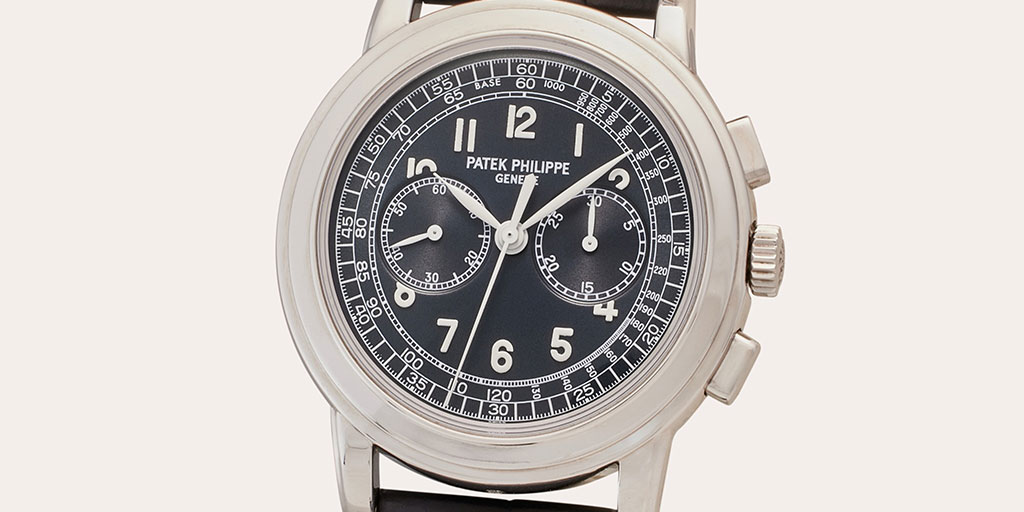
Tiffany & Co. Double-Signed Dials
A limited number of pieces were made for Patek Philippe’s historical retail partner Tiffany & Co., which bear the legendary signature “Tiffany & Co.” at 6 o’clock on the dial. They have been produced in all four regular production metal/dial combinations and are otherwise identical. The Certificate of Origin will have the name “Tiffany & Co.” printed (not handwritten) either in the retailer field or at the bottom of the Certificate of Origin below the date field.
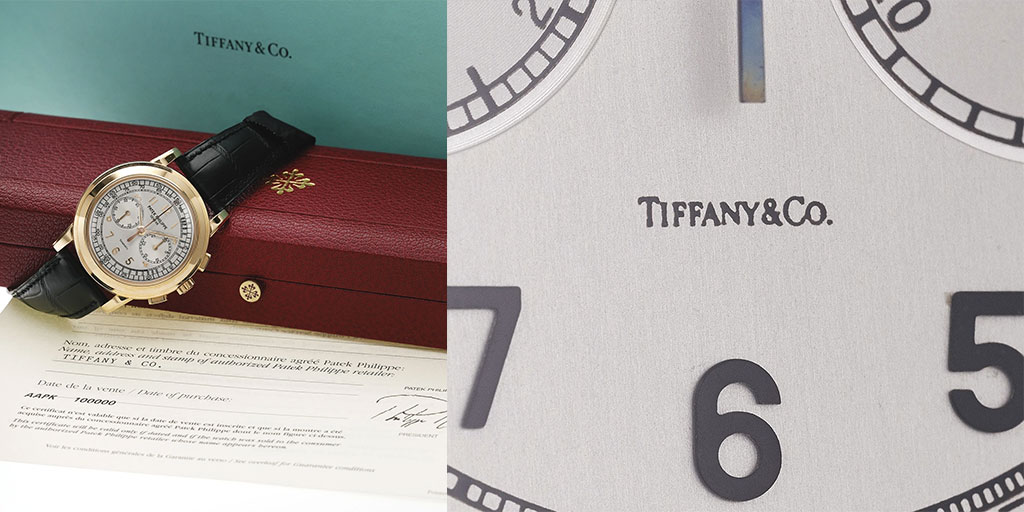
Few pieces have been made, and to date, only one rose gold, two white gold, and one platinum have appeared across the major international auction houses and command a premium compared to the regular production models.
The Diamond-Set Ref. 5071
The large case and bezel of the ref. 5071 was the perfect canvas to offer a highly diamond-set version. It was produced exclusively in white gold between 2001 and 2006 and represents a masterclass in the art of gem setting.
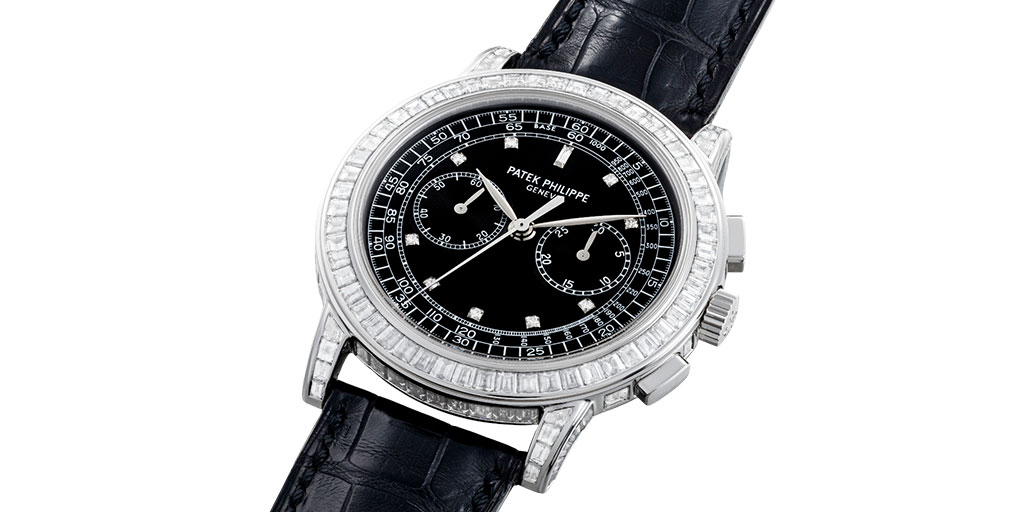
The entire case is set with baguette diamonds on the bezel, case band and lugs. The stones are set using a channel setting (“serti rail”): the baguettes are slid into a channel, then the lips of the channel are burnished down to secure the stones. While the case band has a regular shape – thus standard cut baguette stones can be used – the work on the bezel and lugs is very different. To perfectly follow the round shape of the bezel and the curved and narrowing lugs, the stones must be custom-cut, trapezoidal baguettes to perfectly fit the space and prevent any gaps.
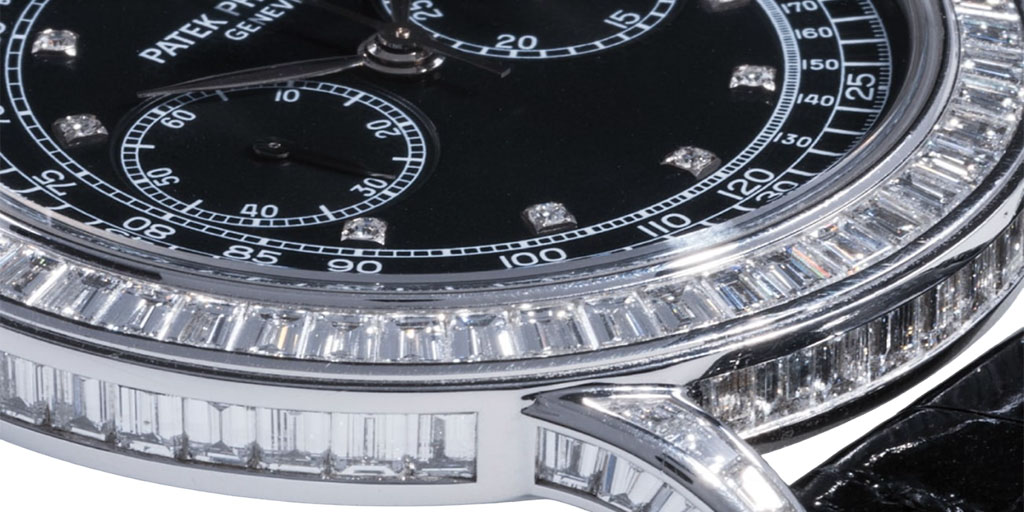
The high quality of the setting is immediately evident. The reflection of light is perfectly uniform, with all diamonds set straight and the rails running perfectly parallel. The stones on the bezel show perfect radial alignment, appearing as a continuous ribbon of light with minimal visible metal as the channel edges seamlessly merge with the diamonds.
Patek Philippe only used the finest diamond quality: “Flawless Top Wesselton”. Using the more common GIA classification, this is the equivalent of an internally flawless (IF) purity and a F-G color range, in both cases on par or above the most recognized high jewelry brands. A specific characteristic of baguette diamonds is that due to their large surfaces, even small impurities become apparent, and due to the close proximity in which the stones are set, the slightest color variations would become evident, requiring particularly meticulous selection. In total, the case is set with 118 baguette-cut diamonds, totaling approximately 11.55 ct.
The black dial is set with diamonds that replace the numerals: eight round diamonds marking the hours and a baguette diamond at 12. The pin buckle is also set with 16 custom-cut baguette diamonds that follow its exact shape.
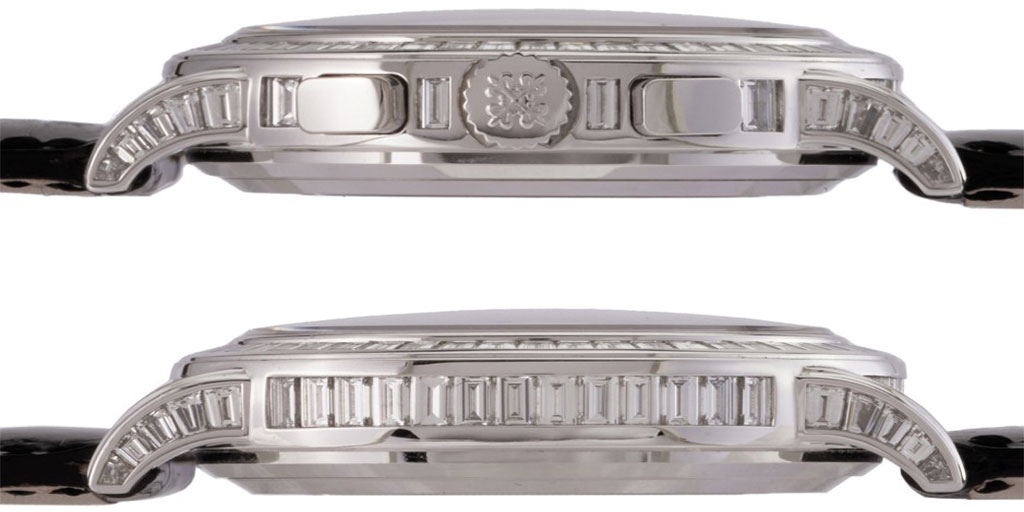
All of this came at a significant premium. As of February 2003, a regular 5070G retailed at €31,090 while the 5071G was €167,480 (France) – that is more than five times the price of a non-set version!
The ref. 5071 was replaced by ref. 5971 in 2007. The exceptional level of setting is evident in that, since the ref. 5071, only few pieces have been known to have been baguette-set on the bezel, case band and both sides of the lugs and include the High Jewelry versions of the Grand Master Chime ref. 6300 and the Minute Repeater Perpetual Calendar ref. 5374 and the Aquanaut Luce ref. 5260 – all watches priced above $1 million.
Collectability
The 5071G is a very rare watch. Due to the craftsmanship required to set the cases, the patience to source and custom-cut the diamonds and the price point, only a handful could have been produced per year. Over the 6-year production span, one could estimate that only 30 to 50 have been made though Patek Philippe has not confirmed these numbers.
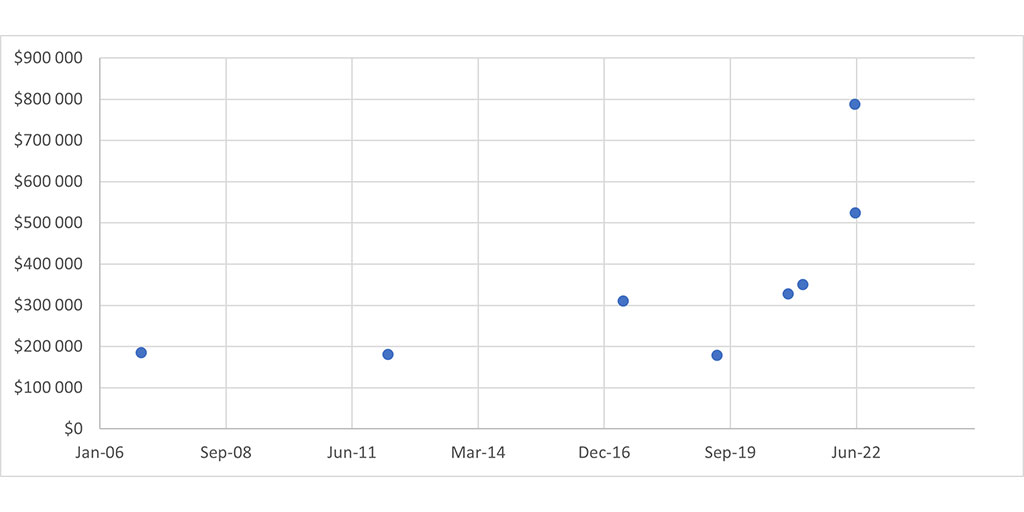
To date, only eight pieces have appeared at auction at the major international houses Antiquorum, Christie’s, Phillips and Sotheby’s. Given the nature of the pieces and the narrow collectors base, considerable price variation can be expected. That said, recent auction results show significant appreciation.
Conclusion
The ref. 5070 stands as a masterclass in purposeful design. Its multi-stepped case architecture, expansive twin-counter dial layout, and bold 42mm proportions create a chronograph of exceptional presence and legibility. The intelligent use of negative space, the harmony between case and dial elements, and the variety offered across four precious metals resulted in a watch that rewards prolonged study.
Equally significant is the caliber CH 27-70, the movement with which Patek Philippe chose to end the ébauche-era before the introduction of its in-house movements in the years to come, regaining total independence.
While the ref. 5070 is sometimes overshadowed by other Patek Philippe pieces, its significance extends beyond its eleven-year production run: it bridged Patek Philippe’s chronograph past and future, proved prophetic in its avant-garde sizing, and delivered technical and aesthetic excellence. As collectors continue to appreciate watches that combine historical importance with wearable elegance, the ref. 5070 deserves recognition not as a transitional piece, but as a landmark achievement in its own right.
Edouard Henn has been passionate about horology since his teenage years. He began his professional journey at Girard-Perregaux in La Chaux-de-Fonds before transitioning to luxury retail across Europe and the Middle East. With a business education background, Edouard brings both product and collector’s perspective to his writing. Now based between Geneva and Paris, he enjoys sharing horological knowledge and connecting with fellow enthusiasts in the watch community.

